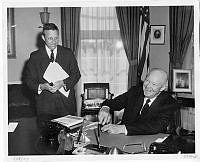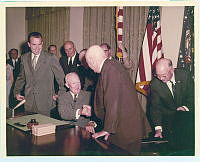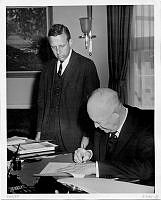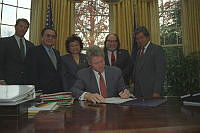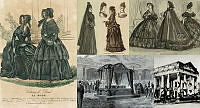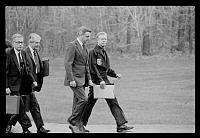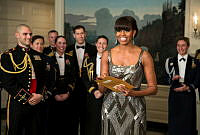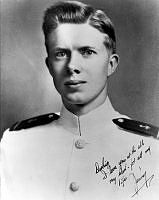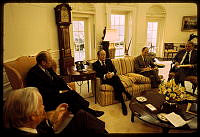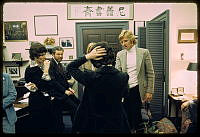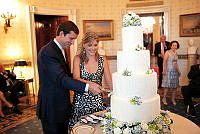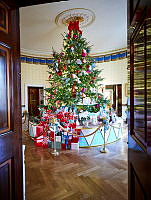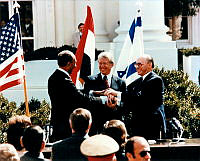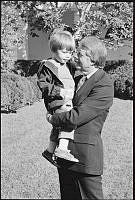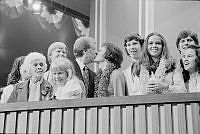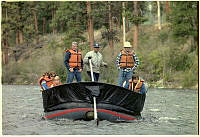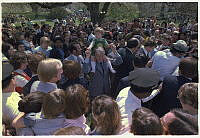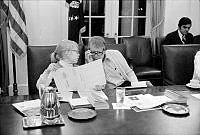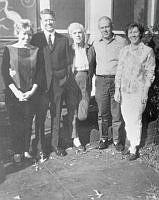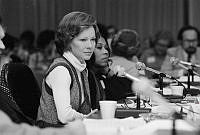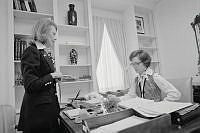Rubenstein Center Scholarship
Passover Celebrations in the White House
On December 9, 1805, President Thomas Jefferson hosted what is believed to be the first ifṭār dinner, breaking the Muslim fast of Ramadan precisely at sunset.1 President Jefferson’s guest of honor, Sultan Soliman Melimeli, was the Tunisian envoy to the United States, whose official visit had begun ten days earlier with the intent of improving the fate of American merchant vessels that had fallen prey to Barbary corsairs. Sultan Soliman’s ifṭār dinner is significant not only because it points to President Jefferson’s interest in Islam2—President Jefferson is known to have owned a Qurʾān3—but also because it represented the president’s accommodation and celebration of religious diversity in the White House. Of course, this ifṭār meal was as much an affair of state that helped smooth international relations between two powers in conflict as it was a religious observance. But that meal in December of 1805 was a landmark moment for shaping the White House as a place to celebrate different faiths.

President Jimmy Carter lights a menorah on December 17, 1979. This was part of the first lighting of the National Menorah celebration.
Jimmy Carter Presidential Library and Museum/NARAJust one week after Sultan Soliman’s ifṭār, the Jews of America celebrated the festival of Hanukkah. Yet it would be nearly two hundred years before the first White House menorah lighting, in 19794 when President Jimmy Carter walked across Lafayette Park to light one candle in a thirty-foot electric menorah.5 And while its proximity to Christmas leads many non-Jews to believe that Hanukkah is the most celebrated or most prominent Jewish festival, the 2013 Pew Research Center survey of Jewish Americans revealed that Passover, not Hanukkah, resonates most with the Jewish community. The Jewish festival of Passover is celebrated in the spring and commemorates the miraculous redemption of the Israelites from Egyptian slavery and their exodus from Egypt. Roughly 70% of American Jews participate in the Passover festive meal known as a Seder,6 whereas only 60% light Hanukkah lights.7 The White House began hosting a Passover Seder more than thirty years ago. The various forms this celebration has taken across the decades tells us about the connection between the president and the American Jewish community.
Although White House Domestic Affairs Advisor Stuart Eizenstat hosted President Jimmy Carter at his own family Seder in 1979, the story of Seder in the White House and its immediate surroundings begins in the Clinton administration. In April 1993, members of President Bill Clinton’s staff held a Seder in the Indian Treaty Room of the Eisenhower Executive Office Building, across the street from the White House. According to the Washington Post, staffers had hoped that President Clinton himself would attend the meal, but he did not end up doing so.8 The meal was catered by Sue Fischer, a fixture in the Washington kosher catering establishment.9 Leading the evening’s rituals was Steve Rabinowitz, Director of Design & Production for the Clinton White House.10 This Seder celebration seems to have been organized primarily to serve members of the White House staff who wanted to accommodate their religious observance in their workplace.
The following year, the Clinton White House seems to have initiated a practice of sending out annual Passover greetings—although the 1994 press release did not mention the Jewish community specifically, but only sent “Heartfelt greetings to all who are gathered to celebrate Passover.”11 The message did mention the universal message of Passover, drawing on the Bible’s story of “the Jews’ liberation from slavery in Egypt.”12 But a year later, President Clinton explained, “During this holiday, millions of Jews around the world draw inspiration from the example of the Israelites, who preserved their beliefs, their culture, and their dignity throughout the brutal winter of slavery.”13 This message was not only historically more accurate than the 1994 message—Judaism as a religion only emerges well after the Israelites’ redemption from slavery in Egypt—but it also explicitly acknowledged the significance of the festival to the Jewish people. While President Clinton’s 1994 message opened with the same sort of universal greeting as his 1993 message, he reached out directly to the American Jewish community in specific. Over the years, the Clinton White House continued to send out messages at Passover,14 connecting the celebration of the festival to events of significance to the American Jewish community. In 1996, he commented that “The seder's bitter herbs and salt water remind us of our sorrow at the death of Yitzhak Rabin and the loss of so many innocents to the evil of terrorism.” He also linked the central themes of the observance of Passover to key themes in American life. In 1997, he pointed out that:
The ageless festival of Passover holds profound meaning for Americans. We began our nation's journey to freedom more than two hundred years ago, a journey that is still not complete. Now we look forward to a new century and a new millennium, strengthened by the knowledge that we, too, have been blessed by God with the vision of a land of great promise set aside for those who cherish freedom.15
In 2001, President George W. Bush continued this tradition by sending out an annual Passover message. In fact, President Bush addressed his message to “Jews around the world”16—not just American Jews. Like President Clinton, President Bush’s 2001 message drew a universal message from the festival, pointing to “Passover's abiding influence, not only as a Jewish holiday, but also as an inspiration to all mankind.”17 But there is no record that the Bush White House held a Passover seder. Indeed, the tradition of a seder would not return to the orbit of the White House until 2009, some sixteen years after the first seder in the Indian Treaty Room.

President Barack Obama and First Lady Michelle Obama host a Passover Seder dinner with friends and staff in the Old Family Dining Room on April 9, 2009.
Official White House Photo by Pete SouzaOn the campaign trail in April 2008, a handful of staffers for then-presidential candidate Barack Obama got together in a windowless room in the basement of the Sheraton Hotel in Harrisburg, Pennsylvania, to celebrate Passover with a seder. One of the organizers, Eric Lesser, was a junior staffer whose role in logistics—packing up the campaign U-Haul—made it possible for him to bring along the matzah, wine, and haggadahs (booklets with the script for the Passover seder) that are the mainstays of any Passover celebration, not to mention a few goodies such as macaroons18—cookies that are a Passover favorite because they are made without wheat flour. The impromptu seder was attended by several of Obama’s close advisors, including Valerie Jarrett, who would go on to serve as senior adviser to President Obama, and Jen Psaki, who served as President Obama’s White House deputy press secretary; as well as Herbie Ziskend and Arun Chaudhary—the latter being the first-ever videographer of the White House.19 As these staffers gathered for the evening celebration of the festival, a Secret Service agent appeared and checked under the table, followed by a voice well-known to all those in attendance. Barack Obama joined the group for the seder, which ritually reenacts a key moment in the lives of the ancient Israelites as they moved from slavery to freedom. As the staffers came to the end of the ritual and recited the closing line, “Next year in Jerusalem,” then-candidate Obama famously added, “Next year in the White House.”
And so it was. Beginning in April 2009, and continuing throughout President Obama’s tenure, the White House celebrated a Passover seder each year. The bonds the president had forged on the campaign trail were maintained, and many of the attendees came throughout President Obama’s two terms. To the extent that the guest list grew, it accommodated the expanding families of the president’s and first lady’s staffs. However, some parts of the seder were unchanged year in and year out—President Obama seems to have done a formidable impression of the Egyptian pharaoh.20 President Obama also modified the traditional Passover liturgy as it appears in the Haggadah to make it a uniquely American holiday: the Obamas’ personal friend Dr. Eric Whitaker read President Abraham Lincoln’s Emancipation Proclamation.21 The theme of redemption from slavery, common to the Haggadah and the Emancipation Proclamation, was of great personal significance to President Obama, who put President Lincoln’s text toward the very end of the seder, when the prophet Elijah (signifying the arrival of an ultimate messianic redemption) is welcomed into the room.22 In his final Passover greeting as president, President Obama explicitly drew connections between Passover and contemporary struggles for freedom, explaining that “We will join millions around the world to celebrate redemption at God’s mighty hand and pray for those who still are denied their freedom.”23

President Barack Obama and First Lady Michelle Obama host a Passover Seder dinner with friends and staff in the Old Family Dining Room on April 28, 2016.
Official White House Photo by Pete SouzaNeither ifṭār nor Passover were celebrated in the Donald Trump White House in 2017, although a year later, President Trump offered remarks before the White House Iftar Dinner on June 6, 2018.24 However, he did not attend the seder organized for staffers in 2017 and 2018,25 and information about seder in 2019 and 2020 is scant. Photographs suggest that the 2017 affair was, like the 1993 seder, held in the Indian Treaty Room.26 If President Obama had personalized the seder and made it his own, President Trump’s absence meant that the seder was primarily an opportunity to accommodate the religious practices of White House staffers. Hence, the seder meal was catered by a kosher caterer; White House spokesman Natalie Strom explained that:
Unlike the previous administration’s celebrations, all food was prepared by a kosher for Passover catering company and other kosher guidelines were followed as closely as possible. There were about 35 people in attendance, both Jewish staff and their families who wanted to celebrate the holiday and non-Jewish staff who were interested in learning about the traditions.27

White House staff gather for the Seder in the Indian Treaty Room of the Eisenhower Executive Office Building on April 10, 2017.
Archived Twitter Account of White House Press Secretary Kayleigh McEnanyFollowing the practice of his predecessors, President Trump sent out Passover greetings, but did so in his distinctive style. In 2017 and 2018, he recognized Passover and Easter together (the two took place in the same week) in his weekly address.28 But in 2019, President Trump sent out a message on Twitter (now X) “Wishing a Happy Passover to all those celebrating in America, Israel, and around the world!”29 accompanied with an image of a Magen Star (Star of David). But by 2020, President Trump acknowledged the difficulties of observing the communal seder mean amidst the COVID-19 pandemic in a brief video message dedicated to Passover alone.30

Vice President Kamala Harris and Second Gentleman Douglas Emhoff hosted the White House Virtual Passover Celebration in 2021.
Official White House Photo by Lawrence JacksonThe election of President Joe Biden in 2020 brought Kamala Harris to the vice presidency and the first Jewish person to hold the role of second gentleman—or, indeed, the role of spouse to any president or vice president. In 2021, Second Gentleman Doug Emhoff led a virtual Passover celebration that was the first to be public.31 If the seders in the Clinton and Trump administrations had served to accommodate the religious needs of staffers, the Biden administration’s virtual celebration (which was not a seder per se) was “a move to expand its outreach to the broader American Jewish community.”32 This event involved both the first and second families and, like President Trump’s 2020 message, invoked the adversity of COVID-19. Held a few days before the start of Passover to give Orthodox families an opportunity to participate, the seder had some 34,000 views on Zoom.33
By 2022, as many religious communities returned to pre-COVID norms, the second family augmented the second virtual Passover celebration with their own seder at the Naval Observatory, the official residence of the vice president.34 At that time, the second gentleman expressed hopes for a full return to in-person celebrations:
The pandemic has forced all of us to adjust or pause some of our favorite traditions and activities, but if we all continue to follow the guidelines that are helping to keep us safe ... we’re gonna win this fight against Covid and we’re all gonna be together in person next year.35
The seder at the Naval Observatory was a traditional kosher catered meal, co-led by Herbie Ziskend (one of the staffers behind the Obama campaign trail seder) and Cynthia Bernstein, Vice President Harris’ director of management and administration.36 Eighteen people attended, a significant increase from the two-person seder shared by Vice President Harris and Second Gentleman Emhoff the previous year.
Although President Biden did not pick up President Obama’s tradition of a Passover seder in the White House, the administration did continue to send out Passover greetings—hoping that “As we close our Seders with the familiar refrain, ‘Next year in Jerusalem,’ we will now offer an additional prayer: Next year in person. Next year, together.”37 The president and first lady sent out video wishes as well.38 And in the tradition of the second gentleman’s virtual Passover celebrations, the Biden White House produced a Passover seder video in 2023 that touched on the themes of the holiday and was hosted by Shelley Greenspan, the White House’s official liaison to the American Jewish Community.39
In 2024, President Biden’s statement on Passover was replete with references to the trauma of the Hamas attacks on Israel on October 7, 2023. Sensitive to the difficulty of celebrating the festival in the shadow of those attacks and the continued trauma of hostages still in captivity, President Biden used his remarks as an opportunity to restate his ironclad commitment to the safety “of the Jewish people, the security of Israel, and its right to exist as an independent Jewish state.”40 He also laid out the White House’s approach to several issues facing the Middle East, explaining:
We are also working to establish an immediate and prolonged ceasefire in Gaza as a part of a deal that releases the hostages and delivers desperately needed humanitarian aid to Palestinian civilians. We will continue to work toward a two-state solution that provides equal security, prosperity, and enduring peace for Israelis and Palestinians. And we are leading international efforts to ensure Israel can defend itself against Iran and its proxies, including by directing the U.S. military to help defend Israel against Iran’s unprecedented attacks last weekend.
And yet, the president and first lady closed out their remarks with an optimistic message, drawing on Passover’s eternal themes of “hope, resilience, and redemption.” Although the story of Passover in the White House reveals a number of twists and turns, at times serving simply to accommodate the religious practices of staffers and at others connecting with the personal narrative of the presidents themselves, the White House’s observance of Passover—not unlike President Jefferson’s observance of ifṭār with Sultan Soliman Melimeli in 1805—blends together matters of international politics and the experience of a shared meal at a focal point of the American consciousness.
About the Author
Phillip I. Lieberman served as a 2023-2024 Research Fellow in the David M. Rubenstein National Center for White House History. He is Associate Professor of Jewish Studies and Law, and Chair of the Department of Classics, at Vanderbilt University. He holds a Certificate in Museum Studies from Northwestern University, a PhD in Near Eastern Studies from Princeton University, and a MA in Talmud from the Jewish Theological Seminary. Among his books are The Fate of the Jews in the Early Islamic Near East (2022), The Cambridge History of Judaism, Volume 5: Jews in the Medieval Islamic World (2021), and the co-edited (with Rakefet J. Zalashik) A Jew’s Best Friend: The Image of the Dog throughout Jewish History (2013). His translation (with Lenn E. Goodman) of Moses Maimonides’ philosophical classic The Guide to the Perplexed is forthcoming in 2024. From 2023 to 2026, he will serve as a visiting faculty member in the Department of History at the United States Naval Academy. Phil studies the interaction of Jewish communities with the broader cultures in which they have been embedded throughout history. His project at the White House Historical Association will explore events, traditions, and ceremonies to illuminate the relationship between the American Jewish community and the White House throughout history.














